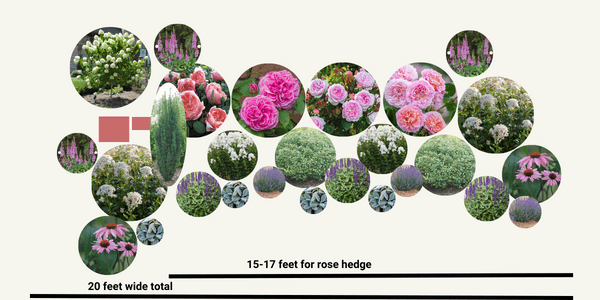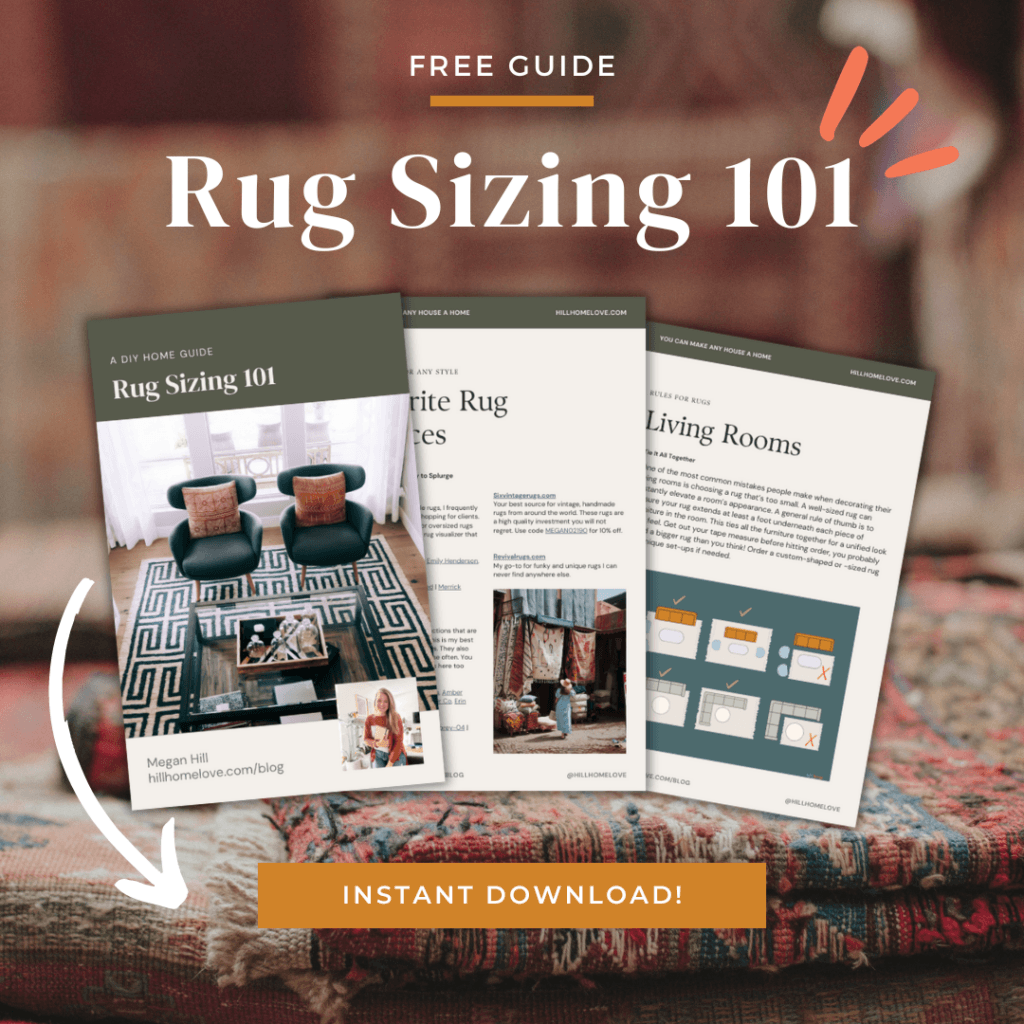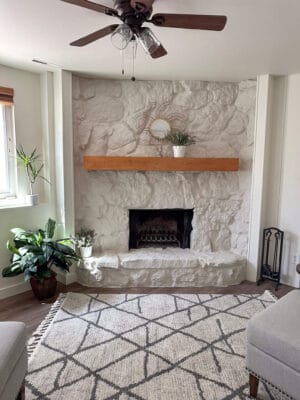Today I’m sharing our cottage style landscape plans for our fixer upper! We’re starting our gardens from scratch, with very little budget.
This week’s mega-post is a goldmine for helpful gardening tips.
- Choosing a garden style
- Cottage style landscape plant varieties, colors, and spacing
- Cottage style companion plants
- Quality cottage plant sources
- The benefits of a garden journal
Read on and happy planting!

Landscaping is one of the best investments you can make in your home. And one benefit of buying a fixer upper is that it’s a blank slate for new landscaping.
Hopefully you can feel my optimism here, knowing our front and back yard are totally devoid of all living things. Except some grass. Yikes.
The freedom to pick and choose our landscaping is both exciting and overwhelming. We don’t have budget to hire a landscape designer or company to do the work for us. And we don’t have budget to redo anything big.
But I’m determined that we can build our front and back gardens on a small budget and make a big difference in the exterior look of our home with a little sweat and hard work.

My dream is to be able to make cut flower bouquets all summer long from my own garden. I need something hardy, easy to maintain, and that gives lots of color.
One of the reasons we picked the Peppermint House for our family was because of this massive backyard. Tons of room for gardens, gardens, and more gardens. It’s come a long way in 10 months, and will only continue to get better.
(This is what it looked like after we moved in last June. Oof.)

Choosing A Garden Style
There are many garden styles to choose from. My absolute favorite, and loved by many, is a perennial cottage style landscape garden. It’s a more informal, wild, and charming look. It attracts lots of butterflies and pollinators and can bloom for three seasons if planned well.
The goal of a cottage style garden is to create a garden that looks like it just sprouted on it’s own. While there needs to be intentionality behind plant spacing, sizes, and varieties, it should look very natural.
For example below:

As opposed to a more contemporary style like this:

Although it can take years to establish a full garden, I know it’s a worthwhile investment to start now.
My hope is to add a more plants, stone, etc. each year! Knowing we’re in our forever home is motivating to get this started. We’ll enjoy the fruits of all this work for years to come.
Cottage Style Plant Varieties
My first priority when choosing a garden style is investing in plants that will come back year after year. I don’t want to waste my time and money by having to plant a whole bunch of things each season. The cost adds up quick.
I scrolled through Pinterest for a few weeks and pinned the landscaping and garden looks I loved most. The trend I noticed was I loved pinks, apricots, purples, and natural grasses. I got obsessed with big, english roses. The idea of being able to walk through a garden of them made me so happy.
Once I knew the main plants I wanted, I started looking for companion plants.
I started researching companion plants for english roses and found lots of resources for a cottage garden look.
DIY Garden Tip
Cottage Style Landscape Essential Plants
There are thousands of varieties to choose from. But I noticed a few key essentials to create an English Garden.
I started with the basics: lavender, salvia, hydrangeas, and english roses.
I added in a few evergreen plants that will stay green through the winter. All-summer blooms like english roses and hydgrangeas. Spring-time show stoppers like double deep pink peonies, and tulips will get planted in the fall. And some Fall blooms like sedum.
I also considered texture, size, shape, and color varieties too. (Keep reading for more tips on that below!)
Our Cottage Style Landscape Plans
Using Canva, I spent a few hours searching for purples, pinks, dark green foliage, and steel blue companion plants. I looked at the plant details for mature plant size, keeping the taller plants in the back, and sketched out a plan below.

I tried to pick a few I liked and stuck to those. There are so many options! Here’s what I ended up choosing.
Front Yard Plant Varieties
- Incrediball Hydrangeas
- Double Peony Dark Pink
- Eupatorium Purple (Joe-Pye Weed)
- Purple Salvia
- English Lavender
- Silver Carpet Lamb’s Ear
- Autumn Joy Sedum (not pictured above)
- “Perfect Picture” Tulips (not pictured above)
Backyard Plant Varieties
- Pink English Roses from David Austin
- Eupatorium Snowball (Joe-Pye Weed)
- Purple Cone Flowers (Echinacea)
- Purple Salvia
- English Lavender
- Foxglove
- Luminary ‘Backlight’ Tall Garden Phlox
- Strongbox Inkberry Holly
- Stonehenge Skinny Yew
- Silver Carpet Lamb’s Ear
- Autumn Joy Sedum (not pictured above)
I plan to add more each year, but this will be a great base to start with.
Cottage Style Landscape Plant Color & Size Tips
1. Place taller plants in the back and shorter plants in the front. You want some height variety through your garden. Plant 2-3 shorter plants of the same variety in a clump to balance our the larger plants around it.
2. Use different textures. Consider bloom shape, foliage texture, bloom size. Add some variety around the garden for visual interest. For example: An english rose is a large round bloom with dark green foliage. Pair it with lavender, which has a spikey bloom and lighter green/silver foliage.
3. Stick to a color scheme. I wanted my pink roses to really stand out. So I complimented the pinks with purples, blues, dark green, silvers, and whites. This will make the roses the showstopper. Dark greens and yellows coordinate well with apricot/orange tones.
David Austin Roses has some helpful tips on color coordinating here:
They also offer free design services if you don’t know where to start! Check out their website for tons of helpful resources like:
Cottage Style Landscape Plant Sources
I highly recommend dutchbulbs.com for perennial spring and fall bulbs! The offer wholesale and bulk pricing for lots of varieties.
I also ordered from:
- https://www.greatgardenplants.com/
- https://www.highcountrygardens.com/
- and https://www.davidaustinroses.com/
Check your local plant nurseries for more options and planting recommendations. Sometimes they offer end-of-season sales or steep discounts during planting season. Plus, you can find more native plants that are more likely to flourish in your specific planting zone.
You can also find plants or starters from groups like Buy Nothing, Facebook Marketplace, or local meet ups for plant swaps!
The Benefits Of A Garden Journal
Keep track of your plants with a garden journal!
Record what you planted and where, make note of how well it grew. Write down if you’d plant it again, how hard it was to maintain, the bloom colors and volume, etc.
This can help you arrange your garden plants. Maybe one needs more shade, and you can try moving it to another location around your house to keep it alive.
This will also save you lots of money, and ensure you’re planting the right flowers for your home. No need to buy a plant you know won’t survive at your house!
There’s lots of DIY options for this. A simple notebook would suffice. I also found this downloadable option on Etsy that seems perfect!
More Cottage Style Landscape Garden Tips
- Plant a “three season garden” by including plants that will bloom at different times throughout the growing season: spring, summer, fall. You can include evergreen plants that will remain green through the winter too.
- Growing an established garden takes time and investment. It’s such a worthwhile effort! Landscaping can increase the value of your home, or at least the appeal. It makes your home so much more beautiful for you to enjoy too.
- Choose plants that fit your ability to maintain. Don’t have tons of time to dehead, water, and give special attention to your gardens? Choose hardy plants that need minimal maintenance. Websites and plant nurseries can guide you to the right varieties for you.
- Many plant websites will ship at the right time to plant according to your zone. Some bulbs have to be planted in the fall, so check labels and desciptions to plant at the right time.
My plants are starting to arrive and I’m anxiously waiting for our last frost to pass. I’ll keep you posted on how well everything grows this season. What are you planting this year at your house?!





